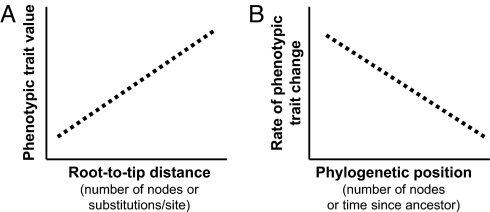Fig. 2.
Two possible relationships between trait values and amount of phylogenetic divergence. (A) Directional evolutionary trend: root-to-tip phylogenetic distance is proportional to phenotypic trait value (e.g., body size, defense). When the x-axis is scaled as the number of nodes, this signifies a correlation between speciation events and trait evolution, possibly implicating the trait as a driver of diversification. When the x-axis is scaled as substitutions/site, this suggests a correlation between molecular divergence and phenotypic evolution. Such directional trends can be estimated with Pagel's scaling parameter β (2). (B) Shifting tempo of phenotypic evolution: scaled phylogenetic distances are proportional to phenotypic trait value. An exponent scales the relationship between phylogenetic distance and trait value; thus, the tempo of phenotypic change varies over time. In this study we used Pagel's δ as the scaling exponent (2). The commonly assumed constant rate of trait change would be represented by a flat line. Here, we assume that the rate of trait change decelerates, as is predicted during adaptive radiation, with early diverging lineages predicted to exhibit higher rates of trait change (and greater variance) as compared to later diverging lineages.

